  |

|
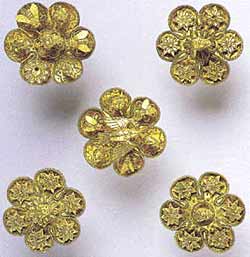
Fig 7 Five rosettes from a
diadem. They were attached to a leather or cloth band (4 of
electrum and the last of gold). From Melos. 7th century BC.
Athens, National Archaeological Museum, XP 1177-1181.
|

Fig. 8 Gold
pendants, "bees". From Thera.
7th century BC.
Athens, National Archaeological Museum, XP. 1065
|
|
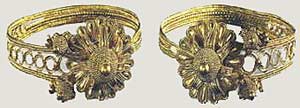
Fig. 9 Gold band
earrings from Sindos.
Late 6th century BC.
Archaeological Museum Thessaloniki, 7975
|
|
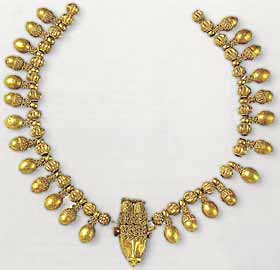
Fig 15 Gold
necklace from Eretria.
5th century BC.
Athens, National Archaeological Museum, XP 10.
|
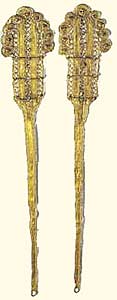
Fig. 10 Gold band
earrings from Chalkidiki.
Last quarter of 6th century BC.
Athens, National Archaeological Museum, ST. 175
|
|
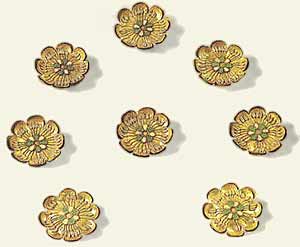
Fig 11 Gold
rosettes with enamel. Possibly from the Hellenspont.
Early 4th century BC.
Athens, National Archaeological Museum, ST 305.
|
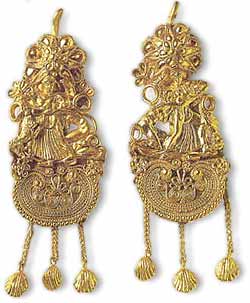
Fig. 12 Pair of
earrings. Peleus wrestling with Thetis. From Eretria.
5th century BC.
Athens, National Archaeological Museum, XP. 928).
|
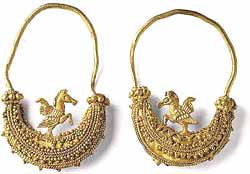
Fig. 13 Gold earrings
of boat-shape type with cock-horse.
First half of 5th century BC.
Athens, National Archaeological Museum, ST. 237.
|

Fig. 14 Gold rings
from tombs at Eretria, on the bezel intaglio representation of
Nike.
5th century BC.
Athens, National Archaeological Museum, XP. 680.
|
|
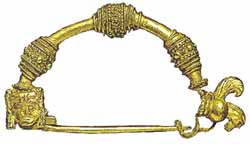
Fig. 16 Gold
fibula classical period.
Athens, Benaki Museum.
|
Archaic and Classical periods
Though metalworking developed apace during the Archaic period (600-475 BC) there
are but scant examples of the goldsmith's art in Greece at that time (figs
9,10). This dearth of gold jewellery (mainly silver, bronze or iron pieces have
survived) can perhaps be explained by the Persian Wars and the fact that the
Persians controlled the Middle East, and consequently the amount of gold
available. However, jewellery-making continued without break throughout this
period, the Greek jewellers turning their attentions to markets abroad,
producing Graeco-Scythian, Graeco-Thracian, Graeco-Etruscan and Graeco-Celtic
ornaments. So when the Persian Wars were over Greek jewellery-making carried on
uninterrupted, creating exquisite works with some notable changes in technique.
The bracelets are formed from a pennanular tube with
animal-head terminals. The rings have round or pointed oval bezels with intaglio
or embossed ornaments and are (fig.14) sometimes set with scarabs and later
sealstones. A few necklaces have been preserved intact. One of the loveliest is
from Eretria, with bull's head at the centre and acorn and ovoid beads (fig.15).
The diadems are usually simple with embossed ornaments bands, the wreaths, gold,
gilded or silver, are rendered naturalistically. The pins are more elegant and
the fibulae usually of silver (fig.16).
|
|


|
Greece jewellery pages Copyright ©
by Add
Information Systems. (Greece)
|
|
  |

